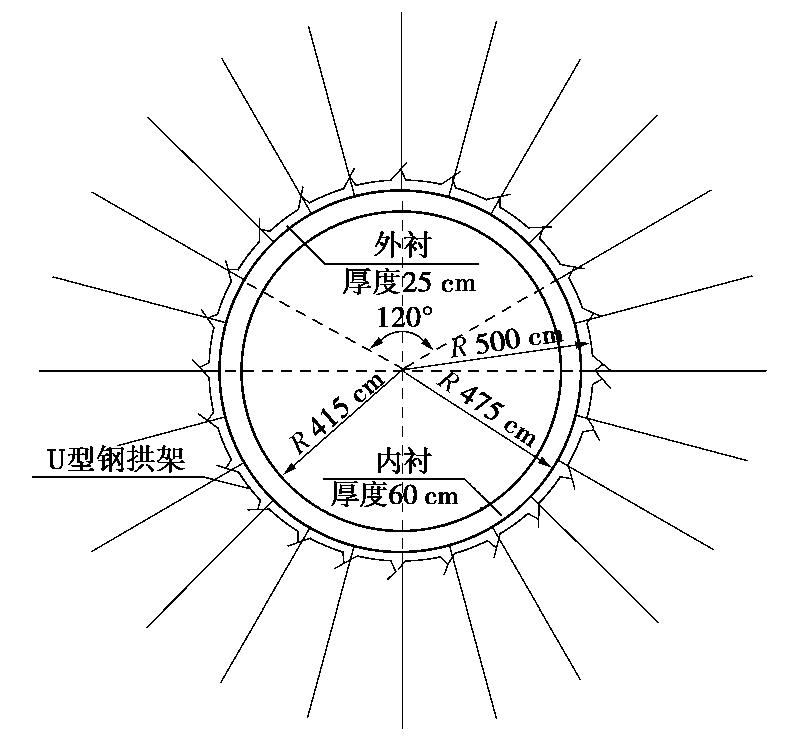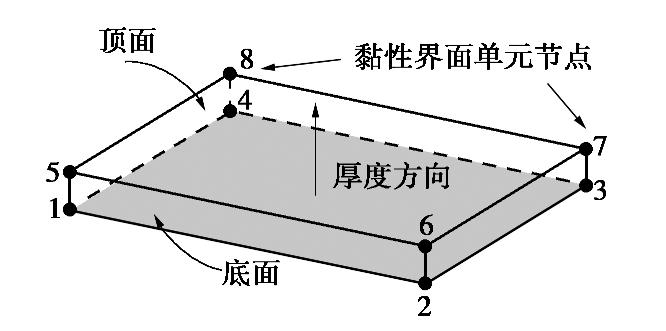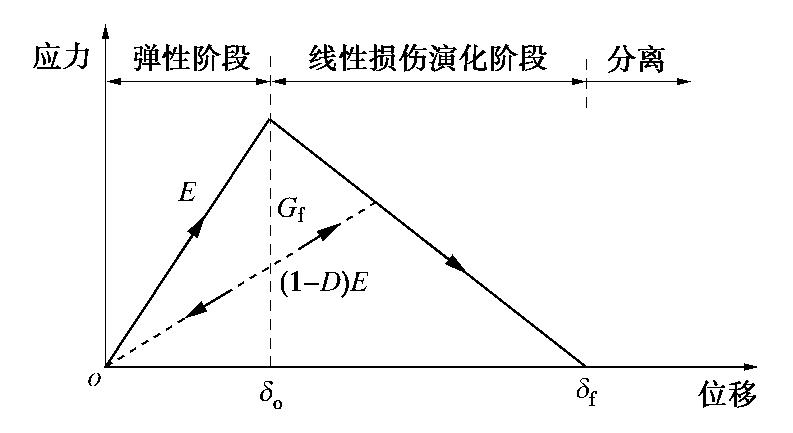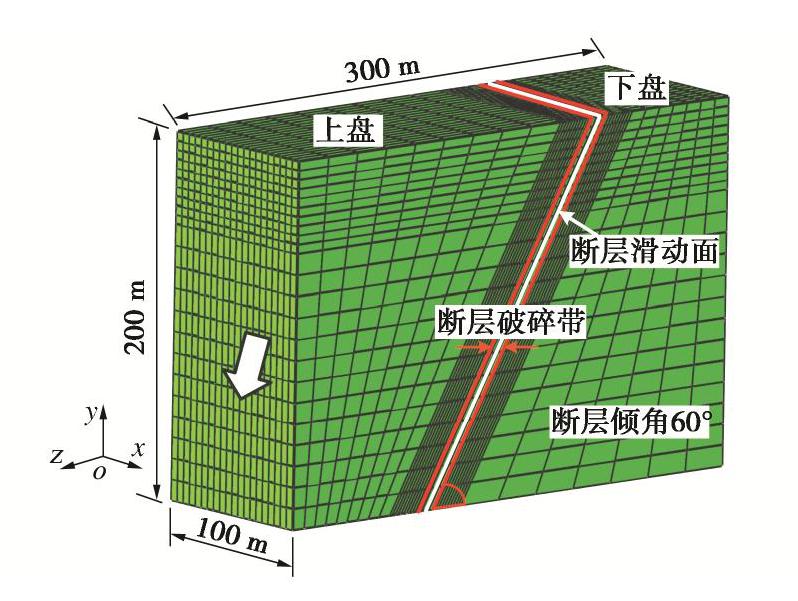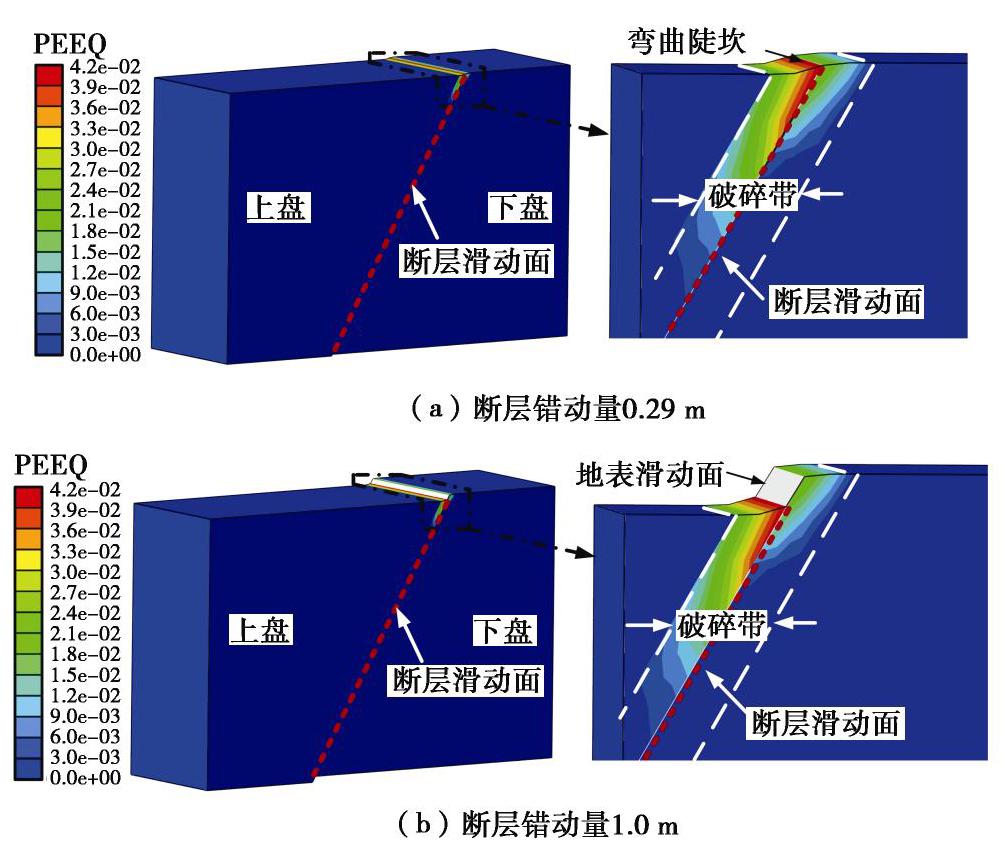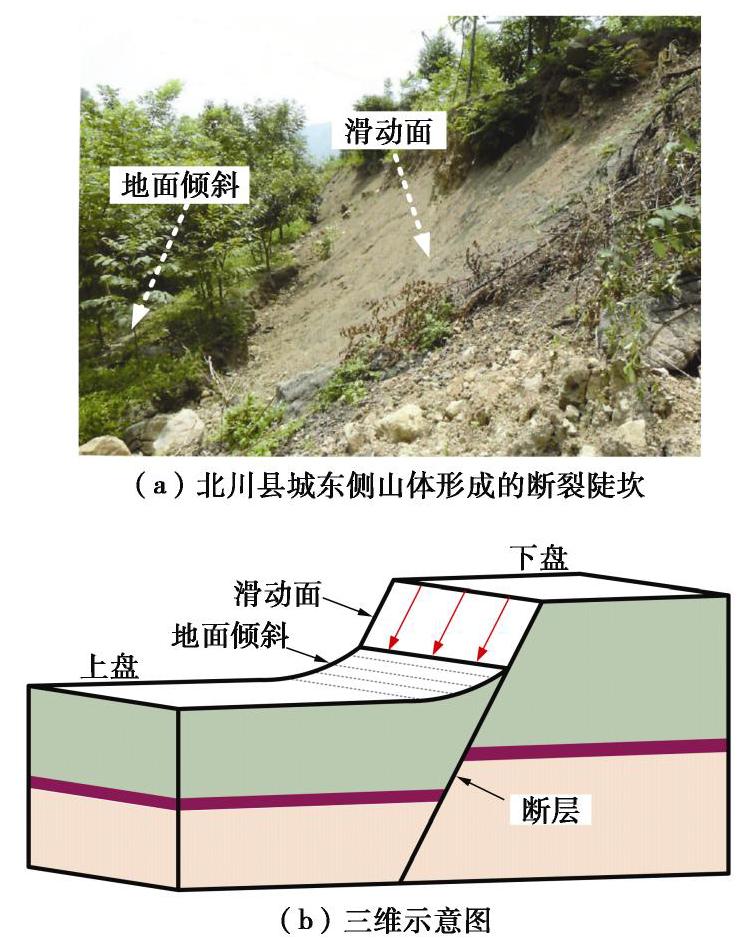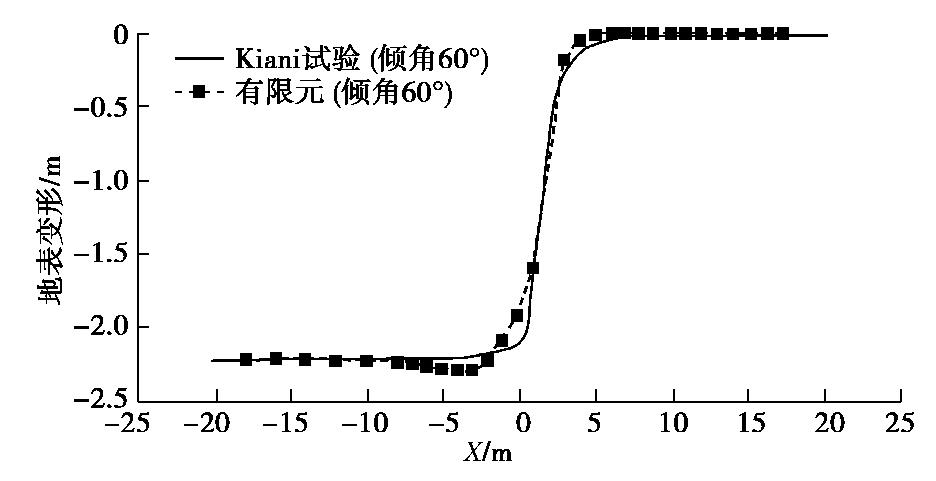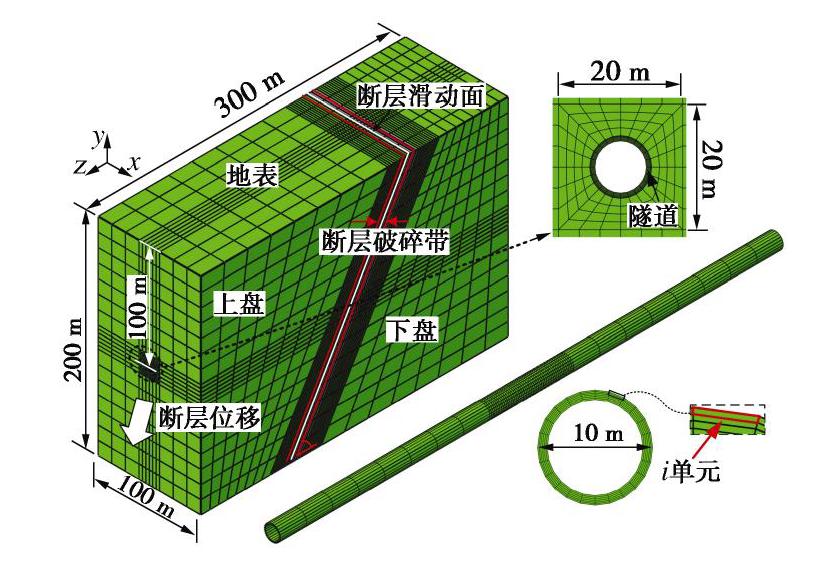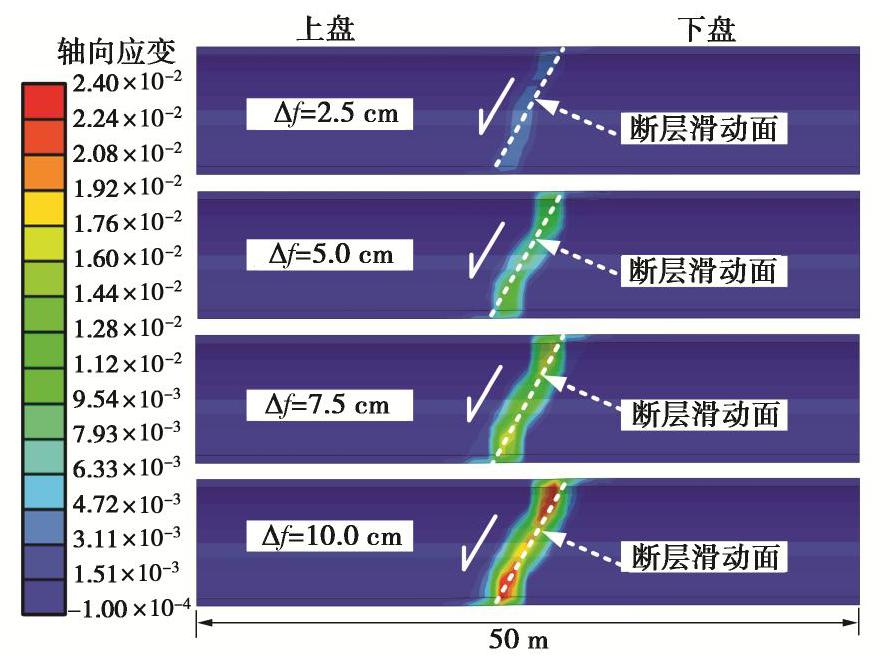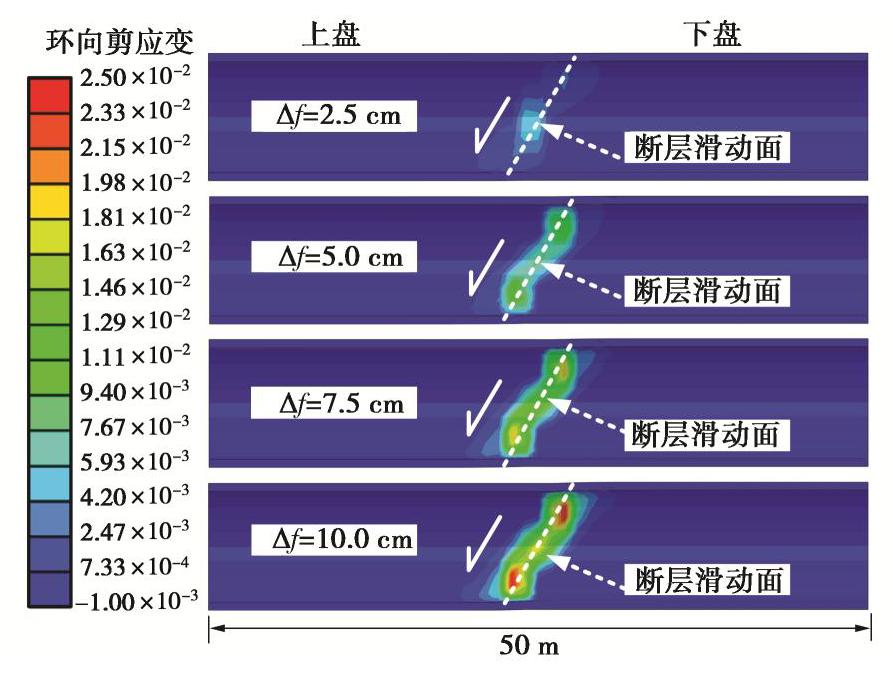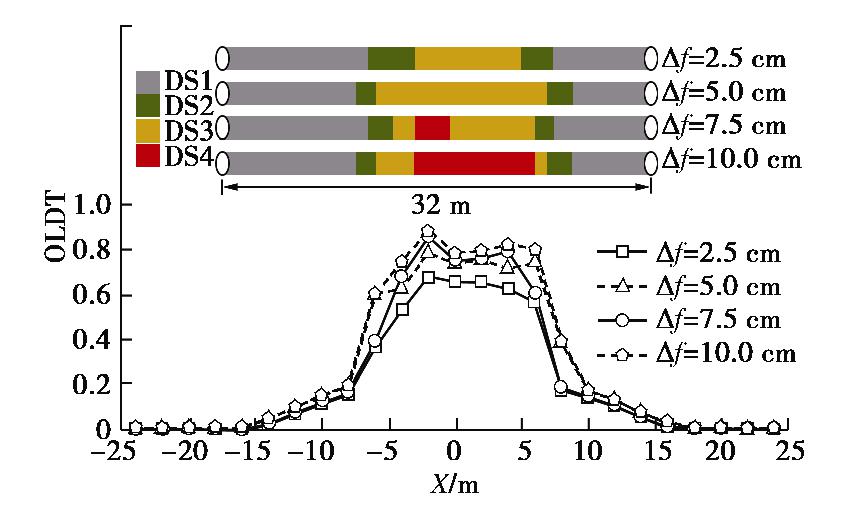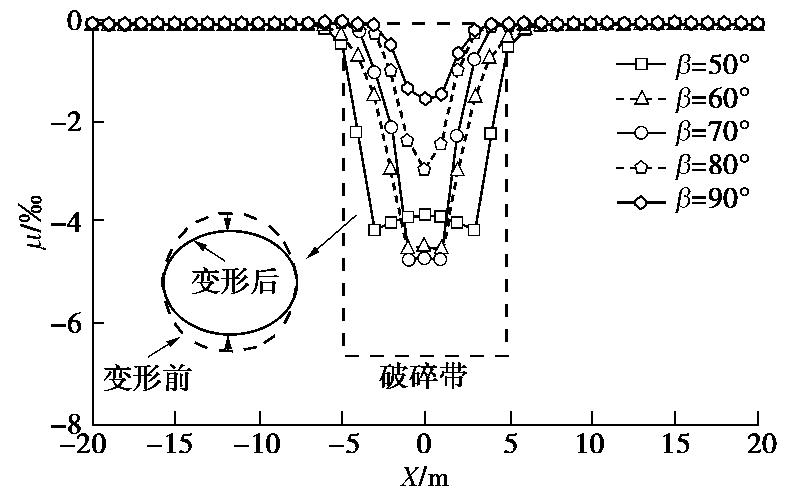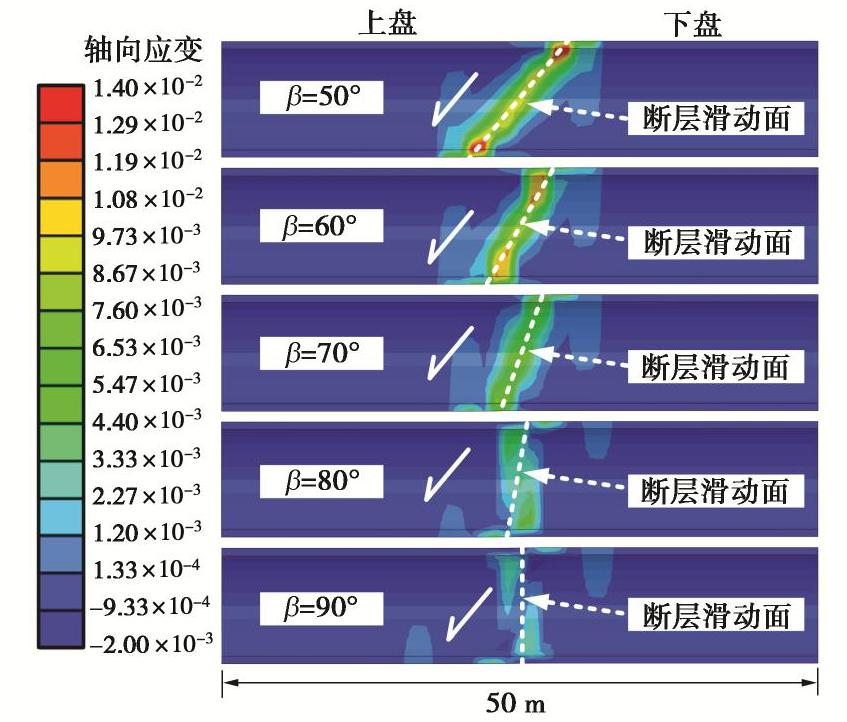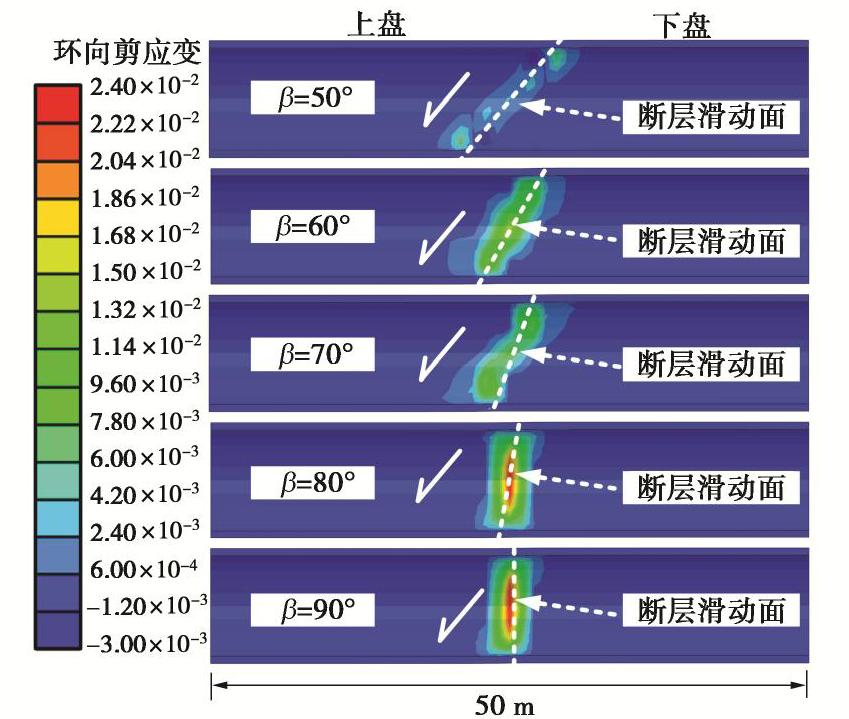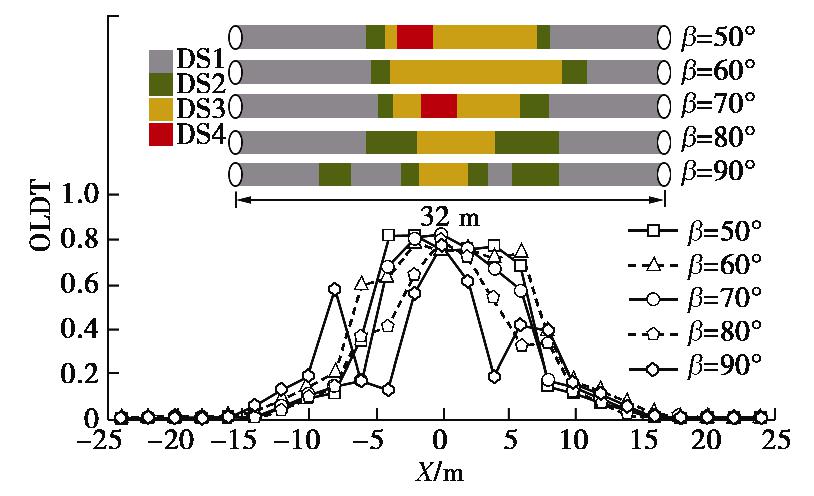Simulation of normal fault rupture and its impact on mountain tunnels
-
摘要: 活动断层的运动和与其相交山岭隧道的震害密切相关,是隧道抗震设计所面临的严峻挑战之一。为此,以滇中引水工程香炉山隧洞为研究背景,运用断裂力学中的黏性界面模型结合有限元方法模拟正断层破裂过程。通过震害调查和试验结果对三维自由场的响应进行验证。进一步建立跨断层隧道三维数值分析模型探讨了不同断层错动量和倾角对隧道响应的影响规律,并引入损伤指数建立隧道安全评价的分类标准对结构的震害进行初步评估。结果表明:正断层错动所引起的地表破裂机制主要有弯曲陡坎和断裂陡坎;隧道衬砌的轴向拉应变和环向剪应变在其与断层滑动面相交位置处达到最大;断层错动量和倾角的变化对隧道不同震害状态沿纵向分布有明显影响;随断层倾角的增大,隧道衬砌处于严重损伤和完全损毁状态的长度要明显减小,断层倾角在50°~70°时对结构安全更为不利。Abstract: The seismic damage of mountain tunnels is closely associated with the movement of active faults. Seismic design of tunnels crossing active faults is one of the great challenges nowadays. Based on the engineering prototype of the Xianglu mountain tunnel, the water diversion project in central Yunnan Province, a numerical method to simulate the propagation of normal fault rupture is proposed using the finite element method incorporated with the cohesive interface model in fracture mechanics. The proposed method is verified against the post-earthquake reconnaissance and experimental results using the three-dimensional free-field model. It is used to simulate a tunnel crossing a normal fault, and the effects of fault displacement and dip angle on the response of the tunnel linings are discussed. Besides, the damage indices and safety assessment criteria are introduced to preliminarily evaluate the damage of the tunnel linings subjected to fault movement. The results show that the mechanisms of surface rupture exhibit the forms of folding or fault scarps under normal faulting. The axial tensile strain and hoop shear strain of the tunnel linings reach the maximum at the position where they intersect the fault slip surface. The seismic damage state of tunnel along the longitudinal direction is significantly affected by the fault displacement and dip angle. The length of the tunnel linings in a severely damaged and completely damaged state is significantly reduced with the increase of the dip angle. Dip angles of 50° to 70° are more detrimental to structural safety.
-
Keywords:
- mountain tunnel /
- normal fault /
- cohesive interface model /
- damage zone /
- lining response
-
0. 引言
随着交通科技的快速发展,中国桥梁建设水平大幅提升,桥梁跨越能力也越来越大,以满足日益增长的交通运输需求,其中悬索桥单跨最大跨径已接近2000 m,跨越能力最强。
悬索桥主要受力构件包括锚碇、塔和主缆,锚碇作为主要承力结构物,一般都采用重力式锚碇,且锚碇基础底板设置于下部持力层上,是支承主缆、保证全桥主体结构受力稳定的关键部位。重力式锚碇包括沉井基础,地连墙基础,复合锚碇基础等。目前国内大跨径桥锚碇基础一般选用沉井基础或者地下连续墙基础。埋置于地下的锚碇基础受到岩土体的支撑及侧向约束作用,特别是变形控制问题需要考虑岩土体与锚碇基础的共同作用,为此提出上部采用沉井基础下部采用钻孔灌注桩的复合锚碇基础形式以满足结构稳定和变形的要求,即桩碇组合结构。桩碇组合结构作为一种新型锚碇基础需要展开针对性研究,传统悬索桥沉井基础与桩碇组合结构基础的结构型式如图1所示。国内外典型大跨径的悬索桥锚碇基础见表1所示。图2给出了悬索主缆拉力随着跨径增加示意图,由图2可见悬索桥跨径随跨径呈非线性增加,从而对锚碇基础提出了更高要求,图3给出了锚碇基础占总造价随悬索桥跨径的变化情况,因此需要对锚碇基础进行深入研究。
表 1 国内外典型大跨径悬索桥重力式锚碇基础Table 1. Typical caisson anchorages of long-span suspension bridges桥名 桥型 主跨径/m 锚碇基础尺寸/m 基础持力层 明石海峡大桥 悬索桥 1990 神户侧(地连墙Φ85×63.5) 沉积岩 淡路侧(沉井80×63×26) 花岗岩 南京仙新路大桥 悬索桥 1760 南锚碇(地连墙Φ68×64) 微风化砾岩 杨泗港长江大桥 悬索桥 1700 南锚碇(地连墙Φ98×36) 坚硬黏土层 北锚碇(地连墙Φ98×44) 坚硬黏土层 虎门二桥 悬索桥 1688 东锚碇(地连墙Φ90×29) 泥岩 西锚碇(地连墙Φ90×35.2) 泥质粉砂岩 西堠门大桥 悬索桥 1650 南锚碇(扩大基础63.6×74.7×50.3) 微风化岩石 北锚碇(扩大基础60.0×81.7×50) 微风化岩石 丹麦大贝尔特桥 悬索桥 1624 两侧锚碇(沉井78×35×20) 砾石 南京长江四桥 悬索桥 1418 南锚碇(地连墙58.2×44.2×76.0) 密实卵砾石 北锚碇(沉井69×51×58) 含砾中粗砂 泰州长江大桥 悬索桥 1080+1080 南锚碇(沉井67.9×52×41) 粉砂 北锚碇(沉井67.9×52×57) 粗砂 马鞍山长江大桥 悬索桥 1080 南锚碇(沉井60.2×55.4×48.0) 圆砾土 北锚碇(沉井60.2×55.4×41.0) 中密中砂 武汉鹦鹉洲大桥 悬索桥 850 南锚碇(Φ66×29) 微风化岩石 北锚碇(Φ66×43) 砾砂 1. 国内外研究现状
陈晓平等[1]、徐涛等[2]以不同沉井基础为研究对象,对其下沉施工进行了全过程实时监测,并利用实测资料系统分析了沉井的下沉机理和受力特性,得到了井壁侧摩阻力和刃脚端阻力的大小和分布特征,以及侧摩阻力沿深度呈抛物线形分布的规律。李宗哲等[3]采用钢筋应力计和土压力计分别监测沉井在下沉过程中的侧摩阻力和刃脚土压力,得到了每节沉井的侧摩阻力、沉井与土层的摩擦系数以及刃脚土压力结果,利用监测数据控制了沉井的安全平稳下沉。邓友生等[4]基于武汉鹦鹉洲长江大桥北锚碇大型圆形沉井的施工过程,建立了沉井和周边土体的三维计算模型,分析了沉井结构及其周围的地下连续防护墙在下沉与封底过程中的应力分布与变形情况,并研究了沉井下沉过程对周边环境的影响。
邓燕羚[5]针对国内首个伴随台风影响的强潮河口处深厚淤泥层地质下的超大型水中沉井基础,通过比较完整的现场实测数据和相应的理论计算研究,采用先进的数值模拟分析方法,对该沉井基础在下沉施工过程中的复杂受力性能、下沉稳定性和地基土体的承载能力进行系统、深入地分析。张计炜[6]以温州市瓯江北口大桥中塔沉井基础为研究对象,采用现场监测、理论计算和数值分析相结合的方法,在全面研究深厚软土层中超大沉井施工下沉全过程的基底端阻力和侧壁摩阻力受力特性及变化规律的基础上,进一步分析沉井下沉前期淤泥层中的突沉机理及相应预防措施,并通过对比分析探索不同施工工况对沉井下沉过程的影响。桩碇组合结构复合锚碇基础在国外已有采用,但由于工程实例少,在国内很少被人注意,目前尚没有采用桩碇组合结构的报导。
2. 基于规范的锚碇设计方法
悬索桥的锚碇设计主要是基于《公路桥涵地基与基础设计规范》JTG D63—2007[7]和《公路悬索桥设计规范》JTG/T D65—05—2015[8]两本规范的相关条款执行。承载力角度需要验算基底承载力、基础稳定和抗滑,将锚碇抽象为刚体的计算简图,不考虑锚碇周围土体的提供约束荷载,得到偏于安全的计算结果。根据《公路悬索桥设计规范》JTG/T D65—05—2015的8.4.2条要求锚碇前、后端基底在施工、运营阶段应不出现拉应力,对基底应力的最大值也提出了要求;同时在8.4.3节对运营阶段锚碇允许水平变位提出不宜大于1 ‱倍的主跨跨径,竖向变位不宜大于2 ‱倍的主跨跨径要求。
3. 基于机理分析的锚碇设计方法
不论是传统的锚碇基础还是改进后的桩碇组合结构基础,基于基础与岩土体的相互作用以及锚碇施工至后期的运营考虑,都需要建立更为真实反应实际物理过程的计算分析模型,才能得到较为合理的计算结果,为锚碇基础的全生命周期运营过程提供数据支撑。分析中需要重点考虑以下几点:①在缆索传递的荷载作用下,锚碇基础、岩土体以及二者之间的界面关系;②地基中的成层饱和土受荷后产生的超孔隙水压力消散;③基础受到水浮力作用。因此,岩土层需要选用刚度非线性并且采用有效应力指标的本构模型,如黏土以及砂性土等土层采用土体硬化模型(HS)以及在此基础上演化而来的考虑小刚度的土体硬化模型(HSS),而反应Mohr-Coulomb强度的黏聚力和内摩擦角均需要采用有效指标,可由固结排水试验获得。HS本构模型应力应变曲线,以及在主应力空间的屈服面分别见图4和图5所示。土体的刚度具有典型的应力依赖性,加载非线性,而且卸载模量与加载不同,因此需要采用HS本构模型或者其演化的本构模型进行计算分析。
由表1可知,很多锚碇基础均嵌入到岩层中,能够反应岩石风化以及节理分布的本构模型为Hoek-Brown模型,该模型不仅引入了地质参数GSI、岩石完整参数
mi 和施工扰动参数D,且可以与传统的岩石本构Mohr-Coulomb参数进行一定的转换,为参数确定提供了便捷。霍克布朗破坏准则采用最大主应力σ1 和最小主应力σ3 的关系式见式(1)所示,式中的参数由式(2)~(4)来确定。σ1=σ3+σc(mbσ3σc+s)a, (1) mb=miexp(GSI−10028−14D), (2) s=exp(GSI−1009−3D), (3) a=12+16[exp(−GSI15)−exp(−203)]。 (4) 岩土层与锚碇基础的界面表达也尤为重要,界面反应相互接触的两种介质的行为,特别是土体的非线性导致界面的非线性,因此需要建立能够反应岩土体的刚度非线性的界面刚度,强度可以通过相邻土体的黏聚力和内摩擦角计算得到的抗剪强度进行控制。对于大型复杂的三维计算分析,沉井基础以及群桩可分别简化为板和桩,桩与岩土体的相互作用用三向弹簧表示,即与桩身轴线相垂直的两个法向弹簧和与之平行的一个剪切弹簧,如图6所示,弹簧刚度则通过周围岩土层的非线性本构模型参数确定。
4. 结语
由于岩土层复杂多变以及悬索桥已有基础或新型基础与岩土层的界面的复杂性,需要在原有规范基础以及机理分析基础上系统开展锚碇基础的深入研究。结合模型试验、现场实测数据及数值模拟分析对不同桩径、桩长、嵌岩深度及土层条件的桩碇组合结构荷载传递机理及变形破坏规律进行研究,提出大跨度悬索桥桩碇组合结构的设计方法,丰富悬索桥锚碇的设计体系。基于室内模型试验及依托工程的计算分析,建立考虑接触及岩土体非线性行为的桩碇组合结构设计计算分析方法,提出桩碇组合结构优化设计方案,为新型复合锚碇基础的推广应用提供技术支撑。
-
表 1 鹤庆—洱源断裂岩石的力学参数
Table 1 Geomechanical parameters of Heqing-Eryuan fault
类型 密度ρ/(103kg·m-3) 弹性模量E/GPa 剪切模量G/GPa 泊松比 内摩擦角φ/(°) 黏聚力c/MPa 抗拉强度ft/MPa 抗剪强度 τ /MPa断裂能G/(N·m-1) 完整岩石 2.9 7.5 — 0.28 45 1.1 — — — 断层破碎带 2.1 1.5 0.56 0.33 29 0.15 0.1 0.3 20 表 2 混凝土损伤塑性模型力学参数
Table 2 Mechanical parameters of concrete damaged plasticity model
参数 数值 密度ρ/(kg·m-3) 2.5×103 弹性模量E/GPa 30 泊松比 0.2 剪胀角ψ/(°) 36.31 压缩屈服应力fc/MPa 20.1 拉伸屈服应力ft/MPa 2.01 -
[1] 洪开荣. 中国隧道及地下工程近两年的发展与展望[J]. 隧道建设, 2017, 37(2): 123-134. https://www.cnki.com.cn/Article/CJFDTOTAL-JSSD201702002.htm HONG Kai-rong. Development and prospects of tunnels and underground works in china in recent two years[J]. Tunnel Construction, 2017, 37(2): 123-134. (in Chinese) https://www.cnki.com.cn/Article/CJFDTOTAL-JSSD201702002.htm
[2] 钮新强, 张传健. 复杂地质条件下跨流域调水超长深埋隧洞建设需研究的关键技术问题[J]. 隧道建设, 2019, 39(4): 523-536. https://www.cnki.com.cn/Article/CJFDTOTAL-JSSD201904001.htm NIU Xin-qiang, ZHANG Chuan-jian. Some key technical issues on construction of ultra-long deep-buried water conveyance tunnel under complex geological conditions[J]. Tunnel Construction, 2019, 39(4): 523-536. (in Chinese) https://www.cnki.com.cn/Article/CJFDTOTAL-JSSD201904001.htm
[3] 何川, 李林, 张景, 等. 隧道穿越断层破碎带震害机理研究[J]. 岩土工程学报, 2014, 36(3): 427-434. https://www.cnki.com.cn/Article/CJFDTOTAL-YTGC201403006.htm HE Chuan, LI Lin, ZHANG Jing, et al. Seismic damage mechanism of tunnels through fault zones[J]. Chinese Journal of Geotechnical Engineering, 2014, 36(3): 427-434. (in Chinese) https://www.cnki.com.cn/Article/CJFDTOTAL-YTGC201403006.htm
[4] 崔光耀, 王明年, 于丽, 等. 汶川地震断层破碎带段隧道结构震害分析及震害机理研究[J]. 土木工程学报, 2013, 46(11): 122-127. https://www.cnki.com.cn/Article/CJFDTOTAL-TMGC201311019.htm CUI Guang-yao, WANG Ming-nian, YU Li, et al. Study on the characteristics and mechanism of seismic damage for tunnel structures on fault rupture zone in Wenchuan seismic disastrous area[J]. China Civil Engineering Journal, 2013, 46(11): 122-127. (in Chinese) https://www.cnki.com.cn/Article/CJFDTOTAL-TMGC201311019.htm
[5] KIANI M, AKHLAGHI T, GHALANDARZADEH A. Experimental modeling of segmental shallow tunnels in alluvial affected by normal faults[J]. Tunnelling and Underground Space Technology, 2016, 51: 108-119. doi: 10.1016/j.tust.2015.10.005
[6] CAI Q P, PENG J M, NG C W W, et al. Centrifuge and numerical modelling of tunnel intersected by normal fault rupture in sand[J]. Computers and Geotechnics, 2019, 111: 137-146. doi: 10.1016/j.compgeo.2019.03.010
[7] 王道远, 崔光耀, 袁金秀, 等. 断裂黏滑错动下隧道减错措施作用效果模型试验研究[J]. 岩土工程学报, 2018, 40(8): 1515-1521. https://www.cnki.com.cn/Article/CJFDTOTAL-YTGC201808021.htm WANG Dao-yuan, CUI Guang-yao, YUAN Jin-xiu, et al. Model tests on effect of dislocation reducing measures of stick-slip fault of tunnels[J]. Chinese Journal of Geotechnical Engineering, 2018, 40(8): 1515-1521. (in Chinese) https://www.cnki.com.cn/Article/CJFDTOTAL-YTGC201808021.htm
[8] 孙飞, 张志强, 易志伟. 正断层黏滑错动对地铁隧道结构影响的模型试验研究[J]. 岩土力学, 2019, 40(9): 3037-3044, 3053. https://www.cnki.com.cn/Article/CJFDTOTAL-YTLX201908020.htm SUN Fei, ZHANG Zhi-qiang, YI Zhi-wei. Model experimental study on the influence of normal fault with stick-slip dislocation on the structure of subway tunnel[J]. Rock and Soil Mechanics, 2019, 40(9): 3037-3044, 3053. (in Chinese) https://www.cnki.com.cn/Article/CJFDTOTAL-YTLX201908020.htm
[9] SABAGH M, GHALANDARZADEH A. Centrifugal modeling of continuous shallow tunnels at active normal faults intersection[J]. Transportation Geotechnics, 2020, 22: 100325.
[10] YAN G M, SHEN Y S, GAO B, et al. Damage evolution of tunnel lining with steel reinforced rubber joints under normal faulting: an experimental and numerical investigation[J]. Tunnelling and Underground Space Technology, 2020, 97: 103223.
[11] 刘学增, 林亮伦, 桑运龙. 逆断层粘滑错动对公路隧道的影响[J]. 同济大学学报(自然科学版), 2012, 40(7): 1008-1014. https://www.cnki.com.cn/Article/CJFDTOTAL-TJDZ201207009.htm LIU Xue-zeng, LIN Liang-lun, SANG Yun-long. Effect of thrust fault stick-slip rupture on road tunnel[J]. Journal of Tongji University(Natural Science), 2012, 40(7): 1008-1014. (in Chinese) https://www.cnki.com.cn/Article/CJFDTOTAL-TJDZ201207009.htm
[12] CHANG Y Y, LEE C J, HUANG W C, et al. Evolution of the surface deformation profile and subsurface distortion zone during reverse faulting through overburden sand[J]. Engineering Geology, 2015, 184: 52-70.
[13] BAZIAR M H, NABIZADEH A, MEHRABI R, et al. Evaluation of underground tunnel response to reverse fault rupture using numerical approach[J]. Soil Dynamics and Earthquake Engineering, 2016, 83: 1-17.
[14] 焦鹏飞, 来弘鹏. 不同倾角逆断层错动对隧道结构影响理论分析[J]. 土木工程学报, 2019, 52(2): 106-117. https://www.cnki.com.cn/Article/CJFDTOTAL-TMGC201902011.htm JIAO Peng-fei, LAI Hong-peng. Theoretical analysis on the influence of different dip angle reverse faults' dislocation on tunnel structure[J]. China Civil Engineering Journal, 2019, 52(2): 106-117. (in Chinese) https://www.cnki.com.cn/Article/CJFDTOTAL-TMGC201902011.htm
[15] ZHAO K, CHEN W Z, YANG D S, et al. Mechanical tests and engineering applicability of fibre plastic concrete used in tunnel design in active fault zones[J]. Tunnelling and Underground Space Technology, 2019, 88: 200-208.
[16] ZAHERI M, RANJBARNIA M, DIAS D, et al. Performance of segmental and shotcrete linings in shallow tunnels crossing a transverse strike-slip faulting[J]. Transportation Geotechnics, 2020, 23: 100333.
[17] FOSSEN H. Structural Geology[M]. New York: Cambridge University Press, 2010.
[18] ZHANG Z Q, CHEN F F, LI N, et al. Influence of fault on the surrounding rock stability of a tunnel: location and thickness[J]. Tunnelling and Underground Space Technology, 2017, 61: 1-11.
[19] 宋佳佳, 孙建孟, 王敏, 等. 断层内部结构研究进展[J]. 地球物理学进展, 2018, 33(5): 1956-1966. https://www.cnki.com.cn/Article/CJFDTOTAL-DQWJ201805024.htm SONG Jia-jia, SUN Jian-meng, WANG Min, et al. Research progress in the internal structure of the fault[J]. Progress in Geophysics, 2018, 33(5): 1956-1966. (in Chinese) https://www.cnki.com.cn/Article/CJFDTOTAL-DQWJ201805024.htm
[20] HOEK E, BROWN E T. Practical estimates of rock mass strength[J]. International Journal of Rock Mechanics and Mining Sciences, 1997, 34(8): 1165-1186.
[21] 中国地震局地壳应力研究所. 2008年汶川8.0级地震科学考察图集[M]. 北京: 地震出版社, 2009. The Institute of Crustal Dynamics, CEA. Scientific Investigation Album of the Wenchuan MS 8.0 Earthquake of 2008[M]. Beijing: Seismological Press, 2009. (in Chinese)
[22] Code of Practice for Temporary Works Procedures and the Permissible Stress Design of Falsework: BS5975—2008[S]. 2008.
[23] 公路隧道设计细则:JTG/T D70—2010[S]. 2010. Guidelines for Design of Highway Tunnel: JTG/T D70—2010[S]. 2010. (in Chinese)
[24] 地下结构抗震设计标准:GB/T 51336—2018[S]. 2019. Standard for Seismic Design of Underground Structures: GB/T 51336—2018[S]. 2019. (in Chinese)
[25] CHEN Z Y, WEI J S. Correlation between ground motion parameters and lining damage indices for mountain tunnels[J]. Natural Hazards, 2013, 65: 1683-1702.
[26] WANG Z Z, ZHANG Z. Seismic damage classification and risk assessment of mountain tunnels with a validation for the 2008 Wenchuan earthquake[J]. Soil Dynamics and Earthquake Engineering, 2013, 45: 45-55.
[27] Federal Emergency Management Agency. Multi-Hazard Loss Estimation Methodology: Earthquake Model HAZUS-MH 2.1 User Manual[R]. Washington D C: FEMA Mitigation Division, 2010.
[28] 刘国庆, 肖明, 陈俊涛. 基于增量动力分析的隧洞结构抗震性能评估[J]. 工程科学与技术, 2019, 51(3): 92-100. https://www.cnki.com.cn/Article/CJFDTOTAL-SCLH201903012.htm LIU Guo-qing, XIAO Ming, CHEN Jun-tao. Seismic performance assessment of tunnel structure based on incremental dynamic analysis[J]. Advanced Engineering Sciences, 2019, 51(3): 92-100. (in Chinese) https://www.cnki.com.cn/Article/CJFDTOTAL-SCLH201903012.htm
-
期刊类型引用(9)
1. 巫茂寅. 素土挤密桩对西北黄土湿陷性影响的试验研究. 中国新技术新产品. 2025(03): 121-123 .  百度学术
百度学术
2. 倪震. 基于分层综合估算法的粉煤灰回填地基承载力研究. 粘接. 2024(02): 147-150 .  百度学术
百度学术
3. 王红肖. 改良黄土抗压强度试验探究. 水利科技与经济. 2024(09): 21-24 .  百度学术
百度学术
4. 刘荆泉,徐昊天,陈文成,陈云泽,章定文. 施工参数对振杆密实法处理液化砂土地基效果的影响研究. 工程勘察. 2024(10): 29-35 .  百度学术
百度学术
5. 化建新,王浩,张丹,梁涛. 地基处理综述及地基处理智能化——第九届全国岩土工程实录交流会特邀报告. 岩土工程技术. 2024(06): 631-643 .  百度学术
百度学术
6. 徐昊天,苟志孝,王正伟,戴梁,章定文. 振杆密实法在高烈度区液化地基处理中的应用研究. 防灾减灾工程学报. 2024(06): 1439-1447 .  百度学术
百度学术
7. 郑圣榆. 国有建筑企业中层管理者绩效考核体系构建研究. 现代企业文化. 2023(09): 137-140 .  百度学术
百度学术
8. 唐文斐. 浅谈西北地区湿陷性黄土地基湿陷机理与处理措施. 房地产世界. 2023(14): 157-159 .  百度学术
百度学术
9. 张振海. 湿陷性黄土地基的沉降规律与特征研究——以某商业楼倾斜事故为例. 重庆建筑. 2022(11): 57-61 .  百度学术
百度学术
其他类型引用(4)




 下载:
下载:






